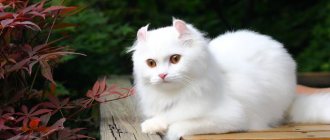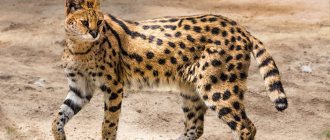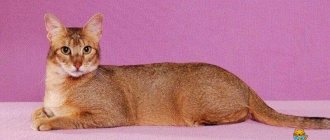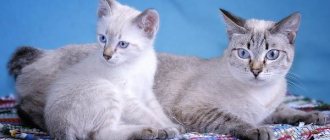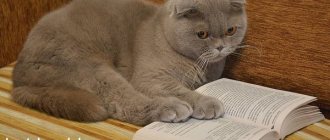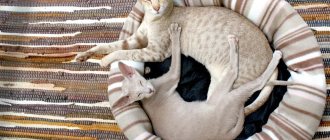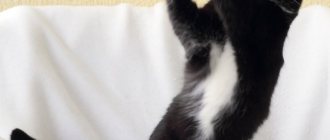Description and features
The cat is slightly larger than average in size, proportionally built, the body looks tightly “knocked together”. The coat is thick, soft and elastic to the touch, and fits tightly to the body. Reminds me of a plush cover. The colors are varied, there are shades of blue and red tones, multi-colored and one color.
The length of adult cats is 50-55 cm without a tail, height 29-32 cm. A cat's weight at 2 years can be 4.3-9.1 kg, and that of a cat 2.5-6 kg. Let us present to your attention a description of the cat based on the standard parameters.
- The head and everything that is on it can be called one definition - rounded. The muzzle, eyes, whisker pads - everything has soft rounded outlines, the skull itself is large, the chin is strong. The eyes are not only round, but large and wide open. The color may vary depending on the coat color.
- The nose is quite wide, but not long; the base is noticeable at the forehead.
- The ears, as the name implies, droop, taking on the appearance of a curved fold; the tip of the ear covers the pinna. They should be pressed tightly and not extend beyond the contours of the head. They may have one or two folds. From the tips to the earlobe you should get a small triangle with the apex at 90 degrees on the earlobe. In adult cats, a person's palm can easily be placed between their ears.
- The body is slightly elongated and looks graceful.
- The width of the hips follows the shoulders, the chest is voluminous.
- The legs can be of medium length or longer, strong, muscular, with round graceful paws.
- The tail is of medium length in relation to the size of the body, sometimes longer, mobile and flexible, tapering at the end. Typically, the longer and more tapered, the more expensive the cost of the animal. Ends with a round tip. A movable tail is valued, since deformities of the joints of this organ occur in the breed.
The Scottish Fold in the photo looks very much like an owl. Large and round eyes on a large head, a prominent nose and an attentive, slightly frightened look. And also dense fur, like thick down. And the ears are almost invisible. Here is such a “bird beast”.
Color
Scottish Fold cats can have any coat color. There are more than 350 variations. Among them, the main ones are: chocolate, black, purple and blue. Next comes the drawing: tiger, spot and marble. And these are only 24 main options. Minor colors include: white, silver, color-point, smoky, gold, each with its own variations, such as ticked or striped, shaded and others, officially recorded.
Taking into account the above, the Scottish Fold merle cat can have the color black merle, blue merle, chocolate merle, lilac merle, as well as all sorts of variations of merle with patterns.
There is a long-haired Scottish Fold breed. Depending on the registry, it is called Highland Fold, Scottish Fold Longhair, or Cupari. Long hair and thick fur is formed exclusively around the upper thighs, toes, tail and ears.
Kinds
It happens that kittens of this breed have ears that remain straight as they age. Then they are called Scottish Straights. Many felinological (“feline” means cat) organizations recognize both of these species as one breed and are presented in the same ring.
The Scottish Straight standard is the same as the folds, except for the ears. In straight-eared animals, they should be small or medium in length, erect with pointed tips. Large at the base and set wide apart. The Scottish Fold color can be divided into several categories:
Classic solid colors, they are called “solid”, which means “strong, stable”:
- The Scottish Fold Black is a true jet black cat. No red tan marks are allowed, this is considered a defect. There may be a couple of white hairs on an anthracite background, but nothing more. A cat with eyes the color of chocolate caramel or dark honey. Very mysterious and effective. In the Scandinavian sagas it can be a companion of a sorceress.
- The Scottish White is a small snowman with bright eyes that can be blue, orange, amber or copper. And they also come in different colors (heterochromia). Kittens have faint spots on their fur; adult cats do not have them.
- Blue (blue color) implies several shades that are considered blue. Some have a color closer to gray, others closer to blue. All hair must be well dyed, then the fur looks the perfect color. Babies may develop small patterns on their fur that disappear after a couple of months. At first, the eyes may have a copper tint, but with age they turn a little yellow.
- Red (fawn) color is not common. A ginger cat from a young age has a color defect - an unevenly colored tail. Sometimes the color goes more red. Animals may have designs on their foreheads, but this is not considered a rule.
- Cream – creamy peach colored fur makes the cat very elegant and gentle. There are patterns on the paws and tail, but not in the form of leopard spots.
- Chocolate Scottish is a rather rare color and looks very beautiful. Kittens have pure chocolate-colored fur; adult cats have a noble bitter-coffee shade.
- Lilac (lavender) Scottish, you can also call it “coffee with milk”. Obtained only from parents of a similar color or. The eyes have all shades of honey - yellow, amber, orange, copper. Nose – beige or light brown.
- Faun (deer) - not to be confused with lilac. The color is a smoky fawn shade, with a chocolate tint on the folds. The nose and paw pads are soft pink.
- Cinnamon Scottish (cinnamon is a variety of cinnamon), the color looks like cocoa with the addition of cinnamon. It differs from chocolate in the bright pink color of its nose and paw pads with a brown tint. The color looks expensive, it is considered so, and it is also very rare.
Bicolor is a color of two colors, one is always white, the other is any of the solid tones. Pedigree cats must have a white face, paws, collar, chest and belly. It is appreciated if the white collar is not closed on the neck, and there is a spot in the form of a white triangle on the muzzle. Eyes of amber shades - bright orange, copper and honey color.
- Particolor (calico) - a combination of white and tortie (tortoiseshell) color, or white and spotted tabby color;
- Harlequin usually captivates at first sight with its elegant colors. The animal has 4/5 white fur, but the tail and ears, as well as the small cap on the head must be black. The belly is white, the nose has a pink tip.
- Van - only the tail is colored, and there are a few small spots on the head. If these spots have a red tint, the cat is called a “red van.” It is common that there are large solid spots on the paws and back, but breeders do not welcome this.
Color point is a rare color similar to the Siamese. On a light tone, darker points stand out - protruding parts of the body: ears, muzzle, tail and legs. The range of colors comes in chocolate, cream, purple, red and blue tones. Scottish cats “borrowed” this color from British cats. The eyes are bright blue, the more contrast, the more valuable.
Colo-point with white is an elite color. These animals look luxurious. In fact, this is a bicolor, only along with the white second shade there is a color-point range. The eyes, as is customary for color-point cats, are blue in different shades.
Ticked. Each hair of a cat's fur is colored in three colors. For example, a black ticked Scottish has light hair at the root, then brown, and black at the top. In this category there are red and blue ticked, black silver. Their eyes are orange-copper or green (usually silver).
Tabby - with bright stripes or spots on a light background. It comes in two types - classic (marbled) and brindle (striped). Kittens may have a pattern of the letter “M” or a butterfly on the back of their heads, and a pattern of rings on their sides, lighter or darker than the background;
Chinchillas are an artificially bred breed with a white undercoat, dark paw pads, and natural “makeup” on the face - a dark border around the eyes, nose and lips. The fur is not long, the colors are ticked and shaded. There are tortoiseshell (only cats), bicolor (expensive colors), smoky (both full and bicolor, van and harlequin). Relatively young breeds are popular - silver chinchilla and golden chinchilla.
Scottish fold colors
- ginger;
- lilac;
- chocolate;
- chinchilla;
- black marble on gold;
- red marble;
- tortoiseshell smoky bicolor;
- tortoiseshell silver ticked harlequin;
- marble or “whiskas”;
- spotted turtle on white;
History of the breed
The ancestor of the Scottish Fold is considered to be a white cat named Susie. It was discovered on a farm near Cupar Angus in Perthshire (Scotland) in 1961. Susie's ears had an unusual curve in the middle, making her resemble an owl. The owner of the farm became interested in such an unusual appearance and decided to keep the cat.
Soon she calved, bringing three kittens with folded ears. One of them was purchased by neighboring farmer and cat lover William Ross. In 1966 he registered the breed with the Governing Council of the Cat Fancy (GCCF), a serious and established organization that has maintained a register of breeding cats in the UK since 1910.
From that moment on, the Scottish Fold breed . Geneticist Pat Turner helped him. In the first three years of the program, 76 kittens were produced, 42 of them with folded ears, 34 with straight ears. It turns out that the famous ear is the influence of a dominant gene, a mutation process.
The first cat with such “wrong” ears, as it was believed, was the ancestor of the world-famous breed. In 1971, the breed was introduced to Europe, but it was not accepted, so the GCCF withdrew its registration. There were many reasons - scientists thought that some cats had deformities in their limbs and tails, which they mistook for a deformity.
There have also been comments about genetic difficulties and ear problems such as infection, mites and deafness. But enterprising Americans purchased cats with folds on their ears, and the breed has already begun to spread throughout the world. American Scottish folds and European ones appeared.
Subsequently, the Scottish Scottish Fold was crossed with the British Shorthair and American Shorthair. By the way, after the first complaints, the breed did not have problems with mites and infections, although these cats may have more wax discharge in the ears than others.
How to choose a kitten
Everyone knows that the problem of choice is not easy in itself. And if you choose a Scottish fold cat as a pet, you need to approach the issue very responsibly.
- Firstly, you can take a kitten from its mother no earlier than the baby reaches the age of 11-13 weeks. This time is enough so that, on the one hand, the kitten can receive all the vital antibodies and nutrients with milk, and on the other hand, it can sufficiently adapt to independent life (eat a variety of food, go to the litter box). It is also very important that by this time an experienced and responsible breeder will have already given the kittens the first required vaccinations. If you want to make a choice earlier than the specified period, you can always arrange a viewing with the owner of the mother cat.
- Secondly, it is very important to remember that characteristic lop ears are the result of a gene mutation, to prevent the negative consequences of which one of the parents must be straight. Compliance with this mating rule can only be guaranteed by professional breeders or specialized breeding nurseries. Buying a visloushka on the market or from random people is absolutely unacceptable.
You have come for a kitten. What should you pay attention to?
Fold kitten
- Baby's tail. The Fd mutation gene, which leads to lop ears, has its effect on the cartilage tissue of other parts of the body, so the tail of a healthy kitten from the “correct” parents should be quite flexible, active, without visible creases or thickenings.
- Behavior of a small Scottish Fold. It is better to buy a kitten that is confident, active and inquisitive. You should not hope that a frightened animal that does not come into your arms and hides in a corner will adapt well and quickly in your home, even if you are persistently convinced of this.
- Don’t hesitate to look under the animal’s tail – it should be dry and clean. The absence of odor from the mouth, discharge from the ears and eyes are signs of a healthy baby.
- Look at the parents of the kittens, find out in what conditions the animals are kept.
When taking your baby home, do not hesitate to ask the breeder all the questions that interest you. And there are many of them: what is the best way to feed kittens, where and when to get vaccinated, what are the main points to consider when caring for your little pet. The information received will help you properly organize the process of getting your baby accustomed to your home and make it as painless and comfortable as possible for both parties.
Character
The character of the Scottish Fold is calm, accommodating and sociable. The animal is not capricious, unpretentious in everyday life, and behaves balanced. It becomes very attached to its owner and its habitat. Doesn't like to attract attention to himself by meowing. What needs to be especially noted here is the cat’s voice.
It doesn't sound like a normal purr, it sounds slightly like a cold, even squeaky. It is clear that the cat does not really like to bother someone. These cats have a very interesting feature - they calmly stand on their hind legs.
They simply stand up and look at what interested them, but was difficult to see from below. Some can even stand like this for a long time, reminiscent of desert animals - meerkats. They also sleep comfortably on their backs. Scottish Fold kittens are cheerful, affectionate, playful, get used to being handled, and can be trained.
They can often be seen at various performances. They quickly get used to the scratching post. Good companions for both adults and children. They don't like noise and can get scared. If you have a small child, it is better to adopt a pet at the age of 3-4 months. They are already socially adapted and understand the basics of independent living.
I would like to note the innate nobility of these animals. Their presence has a positive effect even on dogs, although cats and dogs are usually two irreconcilable categories. And a few words about his delicacy. The cat cannot stand loneliness, but you may not even notice it. He will very tactfully and quietly settle down somewhere nearby.
FAQ
We tell you all about Scottish fold cats.
How do you feel about the arrival of guests?
The Scottish breed calmly tolerates visits from strangers into the house. If they don’t like such company, they will simply find a secluded corner and rest. No aggression is observed in fold-eared cats, even if a stranger tries to pet the animal.
How active
At a young age, representatives of the Scottish breed are quite active. They may chase a fly or a toy. Starting from about 5 years of age, the Scottish Fold cat experiences a more passive life with bouts of activity.
How do they get along with other animals?
Scottish Folds can get along with any animal. Their non-conflict nature is transmitted even to dogs. As a result, different species coexist peacefully with each other.
Are they smart?
Cats of this breed show their intelligence from birth. It's like they're reading minds. You can always negotiate with lop-eared pets. They are able to observe and analyze your actions. And if the Scottish Fold does something wrong, it’s enough to put your palm on their back and gently explain their mistake.
How to feel about loneliness
Scottish Fold cats can be left at home alone without worrying that they will experience stress from being alone. Scottish Folds will wait for you as long as necessary. They organize their own leisure time, play with a toy, watch through the window what is happening on the street. If you need to leave your pet for a long time, you can ask your friends to visit and feed your animal. The Scots will be friendly to the visit of a stranger.
How often and how much do they shed?
The activity of the molting process in the Scottish breed is expressed in the same way as in most breeds. Most of the shed fur is undercoat. It is enough to brush your Scottish Fold cat more often and then the shedding period will pass unnoticed.
Hypoallergenic breed
The Scottish Fold cat is not one of the breeds that is less likely to cause allergies in humans. If you have an allergic reaction to cat hair or saliva, then it is better to avoid this breed.
Weight of Scottish Fold kittens
Scottish Fold kittens are born with a very small weight from 50 to 120 grams. During the first week they grow rapidly and by day 7 they already have a weight gain of 100-200 grams. At the age of six months, the weight of kittens approaches the weight of an adult animal. Females weigh 2.4-3.6 kg, and males 3-5.5 kg.
Nutrition
You can choose natural food for feeding - boiled lean meat (chicken, beef), as well as raw meat (kittens need to be finely chopped or given minced meat), chicken and beef offal (for dark breeds), boiled sea fish, boiled egg yolk, cottage cheese , kefir and other lactic acid products, cereal porridges, sprouted grains of oats and wheat.
Add vitamins, minerals, calcium and stomach hair removal paste. Sometimes give your cat brewer's yeast, dried kelp, fruits or vegetables. These are sources of vitamins and fiber. You can feed them with ready-made premium food or on a natural basis. Don't forget about clean drinking water.
Comparison with British cats
The Scottish Fold is not a British Shorthair breed. At the beginning of its history, the individual was mated with a Briton, which is why the kittens received external characteristics from the British and became similar to them: this is the color of the coat, its length and shape, eye color, and the size of the animal’s body. The exterior of the British cat differs from the Scots cat, although the British cat is just as large, the chin and cheeks of the animal are well defined. The difference in the two breeds can also be replaced in the structure of the paws. The Scots have them more graceful, thin, and long.
The easiest way to determine what kind of breed is in front of you is to look at the animal's ears. But keep in mind that Scots with straight ears are also almost no different from the British. All British cat kittens are born with erect ears. Scottish Straights are a Scottish breed because only a fold-eared cat can produce them in a litter. In fact, erect ears can be partly considered unique to this breed.
Pets are also distinguishable by their personalities. The British Shorthair breed is very aristocratic and arrogant; there may be some coldness towards its owners. She does not tolerate affection or squeezing. All these affections happen only with her permission, whenever she wants. The Scots, on the contrary, are extremely loving animals and are always happy to be stroked, play, and have various events.
Fold cats are not very active vocally, but they talk to their owner by purring. If you put two breeds of the same color next to each other and start talking and playing with them, it will immediately become clear which one is which.
Reproduction and lifespan
A Scottish Fold cat is allowed to be bred no earlier than two years of age. They are bred only with “straight” cats, and vice versa, “fold” cats with straight-eared cats. To pair a “fold”, they select not just any straight-eared breed, but a descendant of a similar mating.
This helps to avoid hereditary bone abnormalities that occur when mating two “folds”. By the way, our “fold” also does not need to be crossed with the British, there may be kittens that do not fall under the standard. Both producers must be healthy and vaccinated. Mating takes place only on the cat’s territory or in any convenient place.
But not in the cat's house. As soon as the gentleman has lost interest in the lady, you can take the cat home. The first month of pregnancy of the visloushka passes unnoticed by anyone. Pay attention to her feeding. If you fed your cat ready-made food, switch to kitten food. There are manufacturers of food specifically for pregnant cats.
In the second month of pregnancy, the cat needs to be fed 3 times a day. Prepare her birth box and introduce her to it. Let her get used to the “children's house”. Pregnancy lasts 60-65 days, maybe a little more. Don't be alarmed if your kitty tolerates a little. Childbirth lasts about a day. Keep an eye on her, she needs your attention.
Yes, and to avoid trouble. There can be from 1 to 6 kittens, but usually 3-4. In each litter, cats can have both “folds” and “straights”. For the first two weeks, you don’t even have to remember about them; the mother cat does everything. She washes them, feeds them, warms them, cleans them. Then they begin to crawl, by the 4th week they can begin to be fed with fermented milk products, soaked food or finely chopped meat.
By the end of the 4th week they will start to climb out of the box, it's time to show them the litter box. These animals are a real joy in the home, and it is important that they live longer. With normal care, feeding and care, pets live up to 10-15 years.
History of the origin of the Scottish Fold
It is officially believed that this breed appeared relatively recently. Most sources indicate the year 1961. It was at this time that an unusual white kitten with small ears folded into an envelope appeared on one of the farms in Scotland. The baby's parents did not differ in any special characteristics. But some descendants of the first Scottish Fold cat had a characteristic ear shape. Trying to consolidate this trait, breeders crossed animals selected according to the required criteria with each other. Unfortunately, practice has shown that such tactics are not successful. Folding occurs only in every fourth kitten. The rest of the animals have straight ears, so they began to be classified as another purebred line - straight-eared Scottish cats (Scottish Straight).
global $ads_google; //data-ad-slot=”2475549904″ $ads_google = empty($ads_google) ? false : true; ?> if ($ads_google == false) {?> $ads_google = true; ?> } ?>
In addition, in a pair of Scottish fold cats and a male cat, kittens were born with disorders of the musculoskeletal system. Such problems with breeding cooled the ardor of English breeders for some time. But, fortunately, in 1978, work resumed with renewed vigor in American nurseries. One of the Scottish kittens ended up in the hands of American geneticist Neil Todd. Thanks to the scientific work carried out, the cause of a hereditary defect was identified when crossing two cats with flattened ears. This trait is determined by a dominant gene, which in the homozygous state causes health problems in the offspring. From that time on, in order to preserve the breed, it was decided to cross Scottish Fold cats with Straight cats, which have straight ears. Thanks to this, the whole world continues to enjoy the company of beautiful and extraordinary animals.
The version about this origin of the breed is officially recognized. However, history claims that Charles Darwin wrote about the unusual Scottish Fold cat in his scientific works. This work of the great evolutionist dates back to 1885. Darwin called the cat Chinese and explained the sign of small ears as a mutation.
But even this small mention of the Scottish Fold is not the first. There is evidence that Europeans first saw a similar animal in 1796. It was then that one sailor brought home from China a cat with an amazing appearance. It is difficult to say to what extent the appearance of this pet corresponded to modern standards. However, there is a version about the eastern origin of the breed.
Care and maintenance
If you decide to purchase a pet such as a Scottish Fold , first arrange for a cat. It is necessary to buy a tray, food and toys in advance so that the baby can immediately adapt to the new place.
The list of mandatory care measures includes:
- Combing. Use a stiff or wire brush. Comb several times, both with and against the coat. These cats love to be brushed against the grain.
- Ears. Clean them carefully at least once a week. They sometimes have excessive sulfur output, which must be removed.
- Eyes. Lightly wipe your eyes with the end of a cotton pad soaked in boiled water once a week.
- Claws. They often know how to use a scratching post. But if you are not accustomed, try to trim once a month.
The animals are not usually sickly, but they do have genetic problems. Bone diseases are the most common. Moreover, these sores can occur at any age - the skeleton may become deformed, the tail may become inactive, or the limbs will begin to thicken. This is called osteochondrodysplasia.
If you notice a change in your pet’s gait, see that he reacts painfully to touching his tail, has no desire to jump, or has a squat appearance in his figure, contact your veterinarian immediately.
It is necessary to monitor the pet's health. In addition, they are susceptible to heart disease, bronchitis, and diabetes. These diseases are not congenital, and also require timely diagnosis and treatment.
A little about diseases
As we have already found out, the gene responsible for the original shape of the ears of “tartan” women also carries hereditary abnormalities of the musculoskeletal system. Of course, fairly careful selection significantly reduces the risk of these defects, but the gene has not yet been completely suppressed.
If you want to buy a Scotsman, you should pay attention to his paws and tail. They must be pliable and very flexible.
Also pay attention to the length and thickness of the tail: individuals with a too short, but also very thick tail are most prone to the disease (osteochondrodystrophy).
Price
The cost of a kitten depends on a number of factors - primarily pedigree, necessary documents, hereditary diseases and habits. There are several classes of pedigree kittens.
- Show class is the elite of this breed. Parents participated in exhibitions and received awards. The cost of such a copy is from 1200 to 2500 euros.
- Breeds are proven healthy babies with a decent pedigree and documents. Allowed for exhibitions. The price ranges from 500 to 1000 euros.
- Pets are purebred pets that were disqualified from participation in exhibitions for minor reasons and are not allowed to breed. This is the best choice if you just want to have a furry pet at home and don’t need a show piece. The average price for a Scottish Fold in this category in nurseries ranges from 100 to 500 euros.
It is advisable to choose well-known nurseries and trusted breeders. Do not try to buy on sales sites, although the cost there may be lower. You must receive a guarantee of purebredness and health. Even if it's a little more expensive. There are nurseries in Russia that breed these cats. For example, in Moscow Ermine Trace.
Pros and cons of the breed
Table - Advantages and disadvantages of the Scottish Fold breed
| Advantages | Flaws |
| Spectacular appearance | Picky eating |
| Calm character, lack of aggression | Pathological attachment to the owner, jealousy |
| Easy to care for | Reluctance to be held |
| Cleanliness | — |
| Affordable price | — |
Scottish Fold cats are ideal for both families with children and single elderly people. These are loyal and gentle pets for whom it is so important to feel loved.
Interesting Facts
- Of the three kittens born from the first Fold Susie, only one continued the breed thanks to William Ross. Of the two remaining on the farm, one was castrated by the owner immediately after birth, the second was a female cat, white like her mother, named Sansa. Unfortunately, at the age of three months, she was hit by a car.
- Scottish red fold cats, unlike British ones, can give birth to both fold-eared and straight-eared heirs.
- Among white Scottish Folds there may be deaf kittens. Before purchasing, test your baby’s hearing by dropping something that rings (a bunch of keys) next to him. If he gets scared and runs away, it means he hears. If he stands still, clap your hands near his nose. Even after that you didn’t move? Then he suffers from deafness.
- The Scottish Fold's tail should not be very thick and fluffy. This was once considered a positive quality, but it was noticed that such a tail leads to thickening of the hind legs, which affects the gait of the animal. Therefore, a tail that is too thick and fluffy is considered a reason for disqualification and reduces the price of the cat.
- The ears of healthy animals can sometimes open and rise for a number of non-dangerous reasons: due to changes in weather, heat, pregnancy, stress. After some time they return to their previous position.
- These cats can watch TV. It is unknown what he understands there and how he evaluates it. But the fact is fixed - the cat sits down and starts watching all the programs with you.
- We all watched a cartoon about Carlson as children, and we remember the famous “housekeeper” Freken Bock from the second part of “Carlson is back.” She had a cat, Matilda. If you noticed, it was a Scottish breed.
Education and training
It is important to understand that an animal is not a cute fluffy (and also fashionable) toy, but a creature that considers itself at least an equal member of your family. When purchasing a Scottish fold cat, you should have a more or less clear understanding of the rules and principles of raising your pet. You need to teach your cat to observe the rules of decency from a very early age, as soon as the baby appears in your home. Considering the natural intelligence of Scottish Folds, this will not be so difficult.
I would fix it, but I have little paws...
Fold-eared people endure loneliness very painfully. Experts do not recommend leaving the animal alone for a long time. To pass the time, kittens either look for something to do on their own or sleep most of the time. In the first case, when you return home, you may find traces of a small pogrom (thrown books, broken vases, pens and pencils scattered on the floor), in the second, a well-slept and rested kitten will endlessly pursue you, demanding unpaid attention. This can be expressed in attempts to climb up your legs onto your lap, and in the desire to lie down beautifully on a desk or computer desk on papers that you are just about to work with, and in biting the fingers of a sleeping owner. This behavior may seem cute at first, but over time it can become annoying.
What to do? The main thing is never drive the animal away. It will definitely not understand the reason for your dissatisfaction and may perceive everything that is happening at this moment as a new game. It would be better to find an opportunity to take a break from work for at least a few minutes and take care of the kitten. Even half a container from Kinder Surprise or a ping-pong ball that you throw on the floor will be suitable as a toy. Catching such “prey” is not so easy, and the baby will become seriously interested in this activity. Be sure to find 15-20 minutes to play with your Scotsman before bed. This minimizes the risk of being woken up in the middle of the night. Trying to feed a kitten at night in the hope that it will calm down will only lead to the fact that the lop-eared one, quickly realizing what’s what, will begin to wake you up every night. There is only one way out - be patient and stubbornly not pay any attention to your pet’s tricks.
Attempts to bite your arms and legs should be stopped firmly and unequivocally. The kitten is raised quite harshly by its mother, so your reluctance to encourage rough play will be accepted by the baby without offense.
Another problem is the animal's natural need to sharpen its claws. Poking your nose into the damaged upholstery of an expensive chair will not help. Buying a scratching post alone will not solve the problem; you will need to teach the cat how to use it. Install the device in a certain place and bring your baby to it several times during the day. Be sure to do this immediately after your little Scottish Fold wakes up. Praise your kitten for correct behavior. Good results are achieved by using special attractive scents. And the smell of orange peels, on the contrary, will discourage you from using an expensive carpet or the back of a sofa as a manicure product.
Scottish Fold cats are very clean, and litter box training usually occurs without any difficulty.
Is it possible to punish an animal? Maybe yes. Using a simple baby rattle gives a good effect. A noisy object (and a cat’s hearing is an order of magnitude better than ours) falling on its back (under no circumstances hit the animal, a light touch is enough) quickly makes it clear to the pet that something is wrong.
But the basis of raising a Scottish Fold cat should still be your love and patience.
Cute fold cat
Beliefs and signs about black cats
In England, where the lineage of fold-eared cats began, the attitude towards black animals is completely different from how they are perceived in eastern countries.
- In Scotland, meeting a black cat is considered a good omen.
- If a black cat enters someone else's house, it means that a happy surprise awaits its owners. This has been believed in the English provinces for many centuries. Therefore, a saucer of milk is often left near the house in case an unfamiliar four-legged guest arrives.
- Black cats are highly prized by British sailors. Since ancient times, such animals have been considered the best rat catchers. For the same reason, farmers selected black cats.
- For the fair sex, a black cat attracts suitors to the house and increases the girl’s chances of a successful marriage.
The black fur of fold-eared cats has not become the subject of a negative reputation for these cats. They look too funny to inspire fear or apprehension when you meet them. With good heredity and proper maintenance, Scots live up to 15 years.
They delight others with their gentle character, good disposition, sociability and impeccable politeness, which is inherent in real Englishmen.
I like3I don't like
